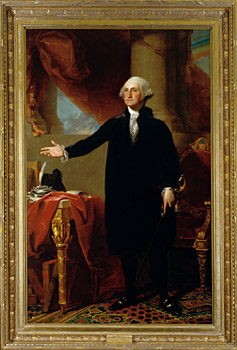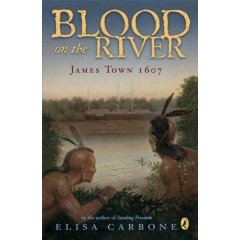Two wonderful examples of the principle that history is best taught through biography just came across my desk. The first is a collection of 56 short sketches of the men who signed the Declaration of Independence. The second (by the same author) has short biographies of the 39 signers of the U.S. Constitution. More details below:
 The Signers by Dennis Brindell Fradin
The Signers by Dennis Brindell Fradin
The 56 men who dared to sign their names to this revolutionary document knew they were putting their reputations, their fortunes, and their very lives on the line by boldly and publicly declaring their support for liberty and freedom. As Benjamin Franklin said as he signed his name, “We must all hang together, or most assuredly we shall all hang separately!”
Many of the names are familiar: John Hancock and John Adams of Massachusetts, and Benjamin Franklin of Pennsylvania, for example. But many of the other 53 have been largely forgotten. This book is an excellent example of the principle that all good history is based on biography. Reading the varied stories of these men’s lives communicates more about the character and lives of the colonists than any textbook. They are presented here in an even-handed fashion, with frank acknowledgment of the difficulties faced by some, especially after the War for Independence was concluded. Several made costly financial mistakes which reduced them to poverty and, in one case, debtor’s prison. But many went on to live rich lives with families, most serving in a variety of positions with state and local government.
The biographies are arranged by state, and a brief profile of each state is provided, along with summary statistics on the wives, children, and death dates of each of the signers.
This is an excellent way to study the Declaration of Independence and the War for Independence. The text is easily accessible to upper elementary students and will be an interesting read for students all the way through high school. I learned a number of fascinating details which I had not known before.
The signers were profiled in several biographical collections from the mid-1800’s, including the volume by Benson J. Lossing written in 1848 and reprinted by Wallbuilders in a facsimile edition. That volume is an important one, and worth reading, but written very much in a mid-Victorian style and tone. It has a tendency to baptize as many of the signers as possible and ignore or obscure even their smallest failings.
This 2003 volume probably does not give enough attention to the faith of the Signers, but it never challenges or denigrates it. All in all, this is a very valuable book, well worth reading.
 The Founders by Dennis Brindell Fradin
The Founders by Dennis Brindell Fradin
Which signer of the Constitution (from a small state) said (to the large state representatives): “I do not, Gentleman, trust you.”
Starting with the delegates from Delaware, who played a critical role in resolving the impasse between the small states and the large states, this collections of biographies is a tremendous help in understanding the history of the writing of the US Constitution. Like their companion volume on the Signers, Fradin and McCurdy give us clear, sober pictures of the 39 men whose signatures are on the federal charter. This is a very valuable resource.
I can’t resist tempting you with a few provocative questions:
George Washington and Benjamin Franklin both signed, but so did 37 others. Do you know who the last surviving signer of the Constitution was, and when he died?
Who represented Rhode Island at the Constitutional Convention? (answer: no one, they feared being absorbed by the larger states and boycotted the convention. Rhode Island also held out on ratifying the Constitution, becoming the last of the 13 colonies to do so in May of 1790 – which was more than a year after George Washington’s inauguration as the first President!
Once again, a book that proves the value of biography in studying history!
– Rob Shearer
Publisher, Greenleaf Press
Directory, Schaeffer Study Center

 The new Lincoln book is the one that came to my attention first. It was published in September of this year. Chuck Wills is an accomplished author and he does an excellent job outlining Lincoln’s life and political career in nine chapters. The text is interspersed with hundreds of photographs and shots of newspaper headlines and front pages. But what really sets this book apart is the inclusion of facsimile reproductions of original documents. About a dozen are included, each
The new Lincoln book is the one that came to my attention first. It was published in September of this year. Chuck Wills is an accomplished author and he does an excellent job outlining Lincoln’s life and political career in nine chapters. The text is interspersed with hundreds of photographs and shots of newspaper headlines and front pages. But what really sets this book apart is the inclusion of facsimile reproductions of original documents. About a dozen are included, each  on a tinted separate heavy-stock sheet slipped into a translucent pocket at the appropriate place in the books narrative. With the chapter discussing Lincoln’s boyhood and education, there is a reproduction of a page from his “sum book.” In the chapter on his marriage and young family, there is a reproduction of his marriage license to Mary Todd. In each case, holding an original document (even it is only a well-crafted facsimile) makes the historical account richer, nearer, more tangible and provokes a more visceral, emotional response. It makes Lincoln much more real, much less abstract. The text is written on an adult level (though certainly not too advanced for high school students), and many students will need some help in absorbing and understanding the historical documents, but I can’t think of a better way to introduce students to the raw materials of history and historical research. For anyone with a historical sense of who Lincoln was (and the text and photographs will give it to you), seeing a flyer for a play at Ford’s Theater on April 14, 1865 and then seeing the “wanted” poster issued in the manhunt for Lincoln’s assassins produces a profound effect. For anyone with an interest in Lincoln, I highly recommend this book – especially if your students have an interest in understanding how historians conduct their research. Note: 2008 will be the bicentennial of Lincoln’s birth. I know its a cliche to study Lincoln around President’s Day, but 2008 will be a special year. Here’s a list of the historical, facsimile documents included in the book:
on a tinted separate heavy-stock sheet slipped into a translucent pocket at the appropriate place in the books narrative. With the chapter discussing Lincoln’s boyhood and education, there is a reproduction of a page from his “sum book.” In the chapter on his marriage and young family, there is a reproduction of his marriage license to Mary Todd. In each case, holding an original document (even it is only a well-crafted facsimile) makes the historical account richer, nearer, more tangible and provokes a more visceral, emotional response. It makes Lincoln much more real, much less abstract. The text is written on an adult level (though certainly not too advanced for high school students), and many students will need some help in absorbing and understanding the historical documents, but I can’t think of a better way to introduce students to the raw materials of history and historical research. For anyone with a historical sense of who Lincoln was (and the text and photographs will give it to you), seeing a flyer for a play at Ford’s Theater on April 14, 1865 and then seeing the “wanted” poster issued in the manhunt for Lincoln’s assassins produces a profound effect. For anyone with an interest in Lincoln, I highly recommend this book – especially if your students have an interest in understanding how historians conduct their research. Note: 2008 will be the bicentennial of Lincoln’s birth. I know its a cliche to study Lincoln around President’s Day, but 2008 will be a special year. Here’s a list of the historical, facsimile documents included in the book: The second book of this type is
The second book of this type is  In
In 


 One of the most fascinating, historically significant moments of the American Civil War (or the War of Northern Aggression. . . or the War for Southern Independence . . . ahem, where was I?) was a naval engagement in 1862. It was a turning point in the war, because the attempt by the small Confederate navy to break the Union blockade with a radical new ship design was ultimately unsuccessful. The engagement was a four hour contest between two ships. Neither was able to sink the other, despite each firing broadside after broadside at each other from point-blank range. Each ship was an “ironclad.” They were the first two ironclads and their encounter changed navies around the world forever.
One of the most fascinating, historically significant moments of the American Civil War (or the War of Northern Aggression. . . or the War for Southern Independence . . . ahem, where was I?) was a naval engagement in 1862. It was a turning point in the war, because the attempt by the small Confederate navy to break the Union blockade with a radical new ship design was ultimately unsuccessful. The engagement was a four hour contest between two ships. Neither was able to sink the other, despite each firing broadside after broadside at each other from point-blank range. Each ship was an “ironclad.” They were the first two ironclads and their encounter changed navies around the world forever. With pencil sketches and watercolor washes, Dan Brown does an excellent job of capturing the life and times of Dolley Madison – beginning when her husband was Secretary of State under Thomas Jefferson and continuing through his own Presidency.
With pencil sketches and watercolor washes, Dan Brown does an excellent job of capturing the life and times of Dolley Madison – beginning when her husband was Secretary of State under Thomas Jefferson and continuing through his own Presidency. We should all be grateful to Dolley as well for saving George Washington. In the President’s residence (remember, it wasn’t the White House yet), was a life-size portrait of George Washington which had been painted by Gilbert Stuart (see picture at left). Although the soldiers guarding the President’s residence had fled, Dolley refused to leave until the portrait was taken down and removed from the residence to a place of safety. Thanks to Dolley, the painting survived.
We should all be grateful to Dolley as well for saving George Washington. In the President’s residence (remember, it wasn’t the White House yet), was a life-size portrait of George Washington which had been painted by Gilbert Stuart (see picture at left). Although the soldiers guarding the President’s residence had fled, Dolley refused to leave until the portrait was taken down and removed from the residence to a place of safety. Thanks to Dolley, the painting survived. Publisher’s Description: “Twelve-year-old Samuel Collier is a lowly commoner on the streets of London. So when he becomes the page of Captain John Smith and boards the Susan Constant, bound for the New World, he can’t believe his good fortune. He’s heard that gold washes ashore with every tide. But beginning with the stormy journey and his first contact with the native people, he realizes that the New World is nothing like he imagined. The lush Virginia shore where they establish the colony of James Town is both beautiful and forbidding, and it’s hard to know who’s a friend or foe. As he learns the language of the Algonquian Indians and observes Captain Smith’s wise diplomacy, Samuel begins to see that he can be whomever he wants to be in this new land.”
Publisher’s Description: “Twelve-year-old Samuel Collier is a lowly commoner on the streets of London. So when he becomes the page of Captain John Smith and boards the Susan Constant, bound for the New World, he can’t believe his good fortune. He’s heard that gold washes ashore with every tide. But beginning with the stormy journey and his first contact with the native people, he realizes that the New World is nothing like he imagined. The lush Virginia shore where they establish the colony of James Town is both beautiful and forbidding, and it’s hard to know who’s a friend or foe. As he learns the language of the Algonquian Indians and observes Captain Smith’s wise diplomacy, Samuel begins to see that he can be whomever he wants to be in this new land.”




